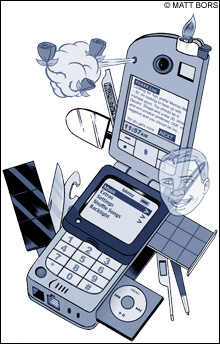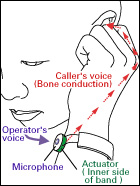 As technology advances over the next two decades, cell phones will morph into new shapes and assume new features. We created some likely scenarios for cellaholics based on the latest lab research and design concepts. Some will happen, some might not. But that thing in your pocket is about to get a whole lot more interesting.
As technology advances over the next two decades, cell phones will morph into new shapes and assume new features. We created some likely scenarios for cellaholics based on the latest lab research and design concepts. Some will happen, some might not. But that thing in your pocket is about to get a whole lot more interesting.
One year out
— Taking a cue from cell phones available in Japan, South Korea, and Finland, handsets in the US will have advanced features: pedometers, large touch screens, four-megapixel cameras, and a slick way to slow down speech with digital technology so the elderly can understand what you’re saying.
— Using a new service by TiVo and Verizon, cell-phone touch screens offer full TV listings for the week. Choose the show you want, and it will be earmarked at the company’s home office. Then you can watch the show full-screen at home or compressed on the cellie during your commute.
— Samsung will release a mobile phone with patented technology that emits perfumes and scents in place of ring tones and vibrating. You can set up the “Smell Phone” with personalized odors for different callers. It might be more pleasant to have your meeting disturbed by lilacs than the Black Eyed Peas.
— The latest Kyocera phone will offer a choice between the Internet or traditional cell-phone networks for making calls. The Voice Over Internet Protocol (VOIP) option is a little cheaper but lower in quality, depending on the time of day.
— Cell phones with 32 gigabyte flash-memory modules, recently announced by Samsung, make it possible to carry around a mini version of your media library. Increased storage also makes it practical for cell phones to carry complete versions of productivity and multimedia software. No more feature-hobbled document viewers with lousy editing abilities.
Three years out
— Just as some 2006 phones bear consumer brands like Disney or Virgin Airlines, future handsets will cater to brands with their functionality. The NASCAR phone will have all the latest pit chats and exclusive video of races. The jewel-encrusted, gold-plated Rolex phone will provide advanced timing and GPS navigation for nautical races and will be marketed to the wealthy fans of America’s Cup Racing. The Spice Channel Phone will have cheap rates and easy (one-handed) dialing for quality 1-900 numbers. The FliXXX Flip Phone will have adult content and collaborative electronic address-book features for gay males.
— In 2006, wireless identification data is already used in phones to order coffee at Quiznos and gasoline at pumps. Future phones will manage sensitive medical data to speed you through a checkup or save you in an emergency. Sensors in the phone will monitor your voice, temperature, and pulse, automatically alerting family members or doctors if you are under extreme stress or “wigging out.”
— Much like today’s blogging communities, a new locality-based, portable communications culture is emerging, where the like-minded find one another by location. Users can convene instantly in any city to stage a large-scale pillow fight or to protest the Iran war.
— The Nike phone will come embedded in a nifty waterproof jacket. Most versions will have you talking through your sleeve. A satellite-phone version will have you talking through your shoe (à la television spy Maxwell Smart). The wet-suit version will feature underwater connectivity allowing you to stay in contact while snorkeling in Kauai.
— Toshiba and Hitachi will finally release hydrogen-fuel cell batteries in ordinary phones. Talk time will rise to days, not hours. Combined with advances in organic solar-cell technology being developed at Princeton University and by DARPA (the people who brought you the Internet), portable devices will just keep on ticking, much like those old solar calculators from the early ’90s still kicking around.
 Five years out
Five years out
— The Sanyo camera will shoot HD video and feature a full editing suite inside the device. You can shoot footage on your handheld and zip it to IFC.com in the same day. Send handmade movies to other phones or nearby TV screens via ultrawide-spread spectrum wireless.
— NASA begins licensing radioisotope-thermoelectric-generator (RTG) batteries like those used to power the Cassini spacecraft. The first consumer product: a nuclear cell-phone battery that offers months of talk time, not days.
— Bio-interactive phones are used to monitor and adjust pharmaceutical dosages in real time. A ZigBee personal network swaps data between the handset and devices such as pacemakers and insulin pumps.
— NTT DoCoMo releases wristwatch-style phones featuring FingerWhisper technology that uses the bones of the human hand as the telephone receiver and as virtual-keyboard input sensors. The user inserts one finger in the ear, and a microphone attached to the wrist unit picks up vocal input. Button presses are initiated by tapping the fingers in a pattern on just about any surface.